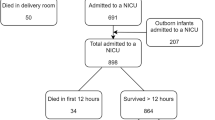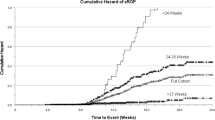Abstract
Objective:
To compare risk-adjusted changes in outcomes of preterm infants <29 weeks gestation born in 1996 to 1997 with those born in 2006 to 2007.
Study Design:
Observational retrospective comparison of data from 15 units that participated in the Canadian Neonatal Network during 1996 to 1997 and 2006 to 2007 was performed. Rates of mortality and common neonatal morbidities were compared after adjustment for confounders.
Result:
Data on 1897 infants in 1996 to 1997 and 1866 infants in 2006 to 2007 were analyzed. A higher proportion of patients in the later cohort received antenatal steroids and had lower acuity of illness on admission. Unadjusted analyses revealed reduction in mortality (unadjusted odds ratio (UAOR): 0.83, 95% confidence interval (CI): 0.63, 0.98), severe retinopathy (UAOR: 0.68, 95% CI: 0.50 to 0.92), but increase in bronchopulmonary dysplasia (UAOR: 1.61, 95% CI: 1.39 to 1.86) and patent ductus arteriosus (UAOR: 1.22, 95% CI: 1.07 to 1.39). Adjusted analyses revealed increases in the later cohort for bronchopulmonary dysplasia (adjusted odds ratio (AOR): 1.88, 95% CI: 1.60 to 2.20) and severe neurological injury (AOR: 1.49, 95% CI: 1.22 to 1.80). However, the ascertainment methods for neurological findings and ductus arteriosus differed between the two time periods.
Conclusion:
Improvements in prenatal care has resulted in improvement in the quality of care, as reflected by reduced severity of illness and mortality. However, after adjustment of prenatal factors, no improvement in any of the outcomes was observed and on the contrary bronchopulmonary dysplasia increased. There is need for identification and application of postnatal strategies to improve outcomes of extreme preterm infants.
This is a preview of subscription content, access via your institution
Access options
Subscribe to this journal
Receive 12 print issues and online access
$259.00 per year
only $21.58 per issue
Buy this article
- Purchase on Springer Link
- Instant access to full article PDF
Prices may be subject to local taxes which are calculated during checkout
Similar content being viewed by others
References
Chan K, Ohlsson A, Synnes A, Lee DS, Chien LY, Lee SK . Survival, morbidity, and resource use of infants of 25 weeks’ gestational age or less. Am J Obstet Gynecol 2001; 185: 220–226.
Lee SK, McMillan DD, Ohlsson A, Pendray M, Synnes A, Whyte R et al. Variations in practice and outcomes in the Canadian NICU network: 1996–1997. Pediatrics 2000; 106: 1070–1079.
Fanaroff AA, Hack M, Walsh MC . The NICHD neonatal research network: changes in practice and outcomes during the first 15 years. Semin Perinatol 2003; 27: 281–287.
Horbar JD, Badger GJ, Carpenter JH, Fanaroff AA, Kilpatrick S, LaCorte M et al. Trends in mortality and morbidity for very low birth weight infants, 1991–1999. Pediatrics 2002; 110: 143–151.
Stoll BJ, Hansen NI, Bell EF, Shankaran S, Laptook AR, Walsh MC et al. neonatal outcomes of extremely preterm infants from the NICHD Neonatal Research Network. Pediatrics 2010; 126: 443–456.
Kramer MS, Platt RW, Wen SW, Joseph KS, Allen A, Abrahamowicz M et al. A new and improved population-based Canadian reference for birth weight for gestational age. Pediatrics 2001; 108: E35.
Richardson DK, Gray JE, McCormick MC, Workman K, Goldmann DA . Score for Neonatal Acute Physiology: a physiologic severity index for neonatal intensive care. Pediatrics 1993; 91: 617–623.
Shennan AT, Dunn MS, Ohlsson A, Lennox K, Hoskins EM . Abnormal pulmonary outcomes in premature infants: prediction from oxygen requirement in the neonatal period. Pediatrics 1988; 82: 527–532.
Papile LA, Burstein J, Burstein R, Koffler H . Incidence and evolution of subependymal and intraventricular hemorrhage: a study of infants with birth weights less than 1,500 gm. J Pediatr 1978; 92: 529–534.
International Committee for the Classification of Retinopathy of Prematurity. The International Classification of Retinopathy of Prematurity revisited. Arch Ophthalmol 2005; 123: 991–999.
Walsh MC, Kliegman RM . Necrotizing enterocolitis: treatment based on staging criteria. Pediatr Clin North Am 1986; 33: 179–201.
Stoelhorst GM, Rijken M, Martens SE, Brand R, den Ouden AL, Wit JM et al. Changes in neonatology: comparison of two cohorts of very preterm infants (gestational age <32 weeks): the Project On Preterm and Small for Gestational Age Infants 1983 and the Leiden Follow-Up Project on Prematurity 1996–1997. Pediatrics 2005; 115: 396–405.
Paul DA, Leef KH, Locke RG, Bartoshesky L, Walrath J, Stefano JL . Increasing illness severity in very low birth weight infants over a 9-year period. BMC Pediatr 2006; 6: 2.
Payne NR, Finkelstein MJ, Liu M, Kaempf JW, Sharek PJ, Olsen S . NICU practices and outcomes associated with 9 years of quality improvement collaboratives. Pediatrics 2010; 125: 437–446.
Doyle LW, Roberts G, Anderson PJ . Outcomes at age 2 years of infants <28 weeks’ gestational age born in Victoria in 2005. J Pediatr 2010; 156: 49–53.
Tommiska V, Heinonen K, Lehtonen L, Renlund M, Saarela T, Tammela O et al. No improvement in outcome of nationwide extremely low birth weight infant populations between 1996–1997 and 1999–2000. Pediatrics 2007; 119: 29–36.
Zeitlin J, Ancel PY, Delmas D, Breart G, Papiernik E . Changes in care and outcome of very preterm babies in the Parisian region between 1998 and 2003. Arch Dis Child Fetal Neonatal Ed 2010; 95: F188–F193.
Itabashi K, Horiuchi T, Kusuda S, Kabe K, Itani Y, Nakamura T et al. Mortality rates for extremely low birth weight infants born in Japan in 2005. Pediatrics 2009; 123: 445–450.
Walsh MC, Yao Q, Horbar JD, Carpenter JH, Lee SK, Ohlsson A . Changes in the use of postnatal steroids for bronchopulmonary dysplasia in 3 large neonatal networks. Pediatrics 2006; 118: e1328–e1335.
Godwin M, Ruhland L, Casson I, MacDonald S, Delva D, Birtwhistle R et al. Pragmatic controlled clinical trials in primary care: the struggle between external and internal validity. BMC Med Res Methodol 2003; 3: 28.
Varughese M, Patole S, Shama A, Whitehall J . Permissive hypercapnia in neonates: the case of the good, the bad, and the ugly. Pediatr Pulmonol 2002; 33: 56–64.
Dempsey EM, Al Hazzani F, Barrington KJ . Permissive hypotension in the extremely low birthweight infant with signs of good perfusion. Arch Dis Child Fetal Neonatal Ed 2009; 94: F241–F244.
Carlo WA, Finer NN, Walsh MC, Rich W, Gantz MG, Laptook AR et al. Target ranges of oxygen saturation in extremely preterm infants. N Engl J Med 2010; 362: 1959–1969.
Muglia LJ, Katz M . The enigma of spontaneous preterm birth. N Engl J Med 2010; 362: 529–535.
Acknowledgements
This study was supported by Grant MOP-53115 from the Canadian Institutes of Health Research. Additional funding was provided by participating hospitals. We thank Woojin Yoon for statistical support of this project. Canadian Neonatal Network coordinating center (Mother-Infant Care Research Center) is supported by Ministry of Health and Long-term Care, Ontario, Canada. Funding agencies had no role in design, collection, analyses or interpretation of results of this study.
Source of funding: Please see Appendix.
Author information
Authors and Affiliations
Consortia
Corresponding author
Ethics declarations
Competing interests
The authors declare no conflict of interest.
Additional information
Presented at the Annual Meeting of the Pediatric Academy Societies, Vancouver, May 2010.
Site Investigators of the Canadian Neonatal Network Shoo K Lee (Director, Canadian Neonatal Network); Prakesh S Shah (Associate Director, Canadian Neonatal Network); Wayne Andrews (Janeway Children's Health and Rehabilitation Centre, St John's, NL); Keith Barrington (St Justine's Hospital, Montreal, QC); Wendy Yee (Foothills Medical Centre, Calgary, AB); Barbara Bullied (Everett Chalmers Hospital, Fredericton, NB); Rody Canning (Moncton Hospital, Moncton, NB); Gerarda Cronin (St Boniface General Hospital, Winnipeg, MB); Kimberly Dow (Kingston General Hospital, Kingston, ON); Michael Dunn (Sunnybrook Health Sciences Centre, Toronto, ON); Adele Harrison (Victoria General Hospital, Victoria, BC); Andrew James (Sick Kids Hospital, Toronto, ON); Zarin Kalapesi (Regina General Hospital, Regina, SK); Lajos Kovacs (Jewish General Hospital, Montreal, QC); Orlando da Silva (St Joseph's Health Centre; London, ON); Douglas D McMillan (IWK Health Centre, Halifax, NS); Prakesh Shah (Mount Sinai Hospital, Toronto, ON); Cecil Ojah (St John Regional Hospital, St John, NB); Abraham Peliowski/Khalid Aziz (Royal Alexandra Hospital, Edmonton, AB); Bruno Piedboeuf (Centre Hospitalier Universitaire de Quebec, Sainte Foy, QC); Patricia Riley (Montreal Children's Hospital, Montreal, QC); Daniel Faucher (Royal Victoria Hospital, Montreal, QC); Nicole Rouvinez-Bouali (Children's Hospital of Eastern Ontario, Ottawa, ON); Koravangattu Sankaran (Royal University Hospital, Saskatoon, SK); Mary Seshia (Health Sciences Centre, Winnipeg, MB); Sandesh Shivananda (Hamilton Health Sciences Centre, Hamilton, ON); Zenon Cieslak (Royal Columbian Hospital, New Westminster, BC); Anne Synnes (Children's and Women's Health Centre of British Columbia, Vancouver, BC); and Herve Walti (Centre Hospitalier Universitaire de Sherbrooke, Fleurimont, QC).
Contribution of authors
Prakesh S Shah: initiated concept, developed draft, analyzed data and wrote the manuscript; Koravangattu Sankaran: participated in design, review of protocol and manuscript writing; Khalid Aziz: participated in design, concept, and revision and editing of the manuscript; Alexander C Allen: participated in design, interpretation and revision of the manuscript; Mary Seshia: initiated concept, participated in design, contributed in writing and editing of the manuscript; Arne Ohlsson: initiated concept, participated in design, contributed in writing and editing of the manuscript; and Shoo K Lee: participated in the design of study, review of results and manuscript preparation.
Appendix
Appendix
Site Investigators of the Canadian Neonatal Network
Shoo K Lee (Director, Canadian Neonatal Network); Prakesh S Shah (Associate Director, Canadian Neonatal Network); Wayne Andrews (Janeway Children's Health and Rehabilitation Centre, St John's, NL); Keith Barrington (St Justine's Hospital, Montreal, QC); Wendy Yee (Foothills Medical Centre, Calgary, AB); Barbara Bullied (Everett Chalmers Hospital, Fredericton, NB); Rody Canning (Moncton Hospital, Moncton, NB); Gerarda Cronin (St Boniface General Hospital, Winnipeg, MB); Kimberly Dow (Kingston General Hospital, Kingston, ON); Michael Dunn (Sunnybrook Health Sciences Centre, Toronto, ON); Adele Harrison (Victoria General Hospital, Victoria, BC); Andrew James (Sick Kids Hospital, Toronto, ON); Zarin Kalapesi (Regina General Hospital, Regina, SK); Lajos Kovacs (Jewish General Hospital, Montreal, QC); Orlando da Silva (St Joseph's Health Centre; London, ON); Douglas D McMillan (IWK Health Centre, Halifax, NS); Prakesh Shah (Mount Sinai Hospital, Toronto, ON); Cecil Ojah (St John Regional Hospital, St John, NB); Abraham Peliowski/Khalid Aziz (Royal Alexandra Hospital, Edmonton, AB); Bruno Piedboeuf (Centre Hospitalier Universitaire de Quebec, Sainte Foy, QC); Patricia Riley (Montreal Children's Hospital, Montreal, QC); Daniel Faucher (Royal Victoria Hospital, Montreal, QC); Nicole Rouvinez-Bouali (Children's Hospital of Eastern Ontario, Ottawa, ON); Koravangattu Sankaran (Royal University Hospital, Saskatoon, SK); Mary Seshia (Health Sciences Centre, Winnipeg, MB); Sandesh Shivananda (Hamilton Health Sciences Centre, Hamilton, ON); Zenon Cieslak (Royal Columbian Hospital, New Westminster, BC); Anne Synnes (Children's and Women's Health Centre of British Columbia, Vancouver, BC); and Herve Walti (Centre Hospitalier Universitaire de Sherbrooke, Fleurimont, QC).
Rights and permissions
About this article
Cite this article
Shah, P., Sankaran, K., Aziz, K. et al. Outcomes of preterm infants <29 weeks gestation over 10-year period in Canada: a cause for concern?. J Perinatol 32, 132–138 (2012). https://doi.org/10.1038/jp.2011.68
Received:
Revised:
Accepted:
Published:
Issue Date:
DOI: https://doi.org/10.1038/jp.2011.68
Keywords
This article is cited by
-
Who’s afraid of the X? Incorporating the X and Y chromosomes into the analysis of DNA methylation array data
Epigenetics & Chromatin (2023)
-
Advances in neonatal cell therapies: Proceedings of the First Neonatal Cell Therapies Symposium (2022)
Pediatric Research (2023)
-
Iron supplementation and the risk of bronchopulmonary dysplasia in extremely low gestational age newborns
Pediatric Research (2023)
-
Associations between maternal residential rurality and maternal health, access to care, and very low birthweight infant outcomes
Journal of Perinatology (2022)
-
Short term outcomes of extremely low birth weight infants from a multicenter cohort study in Guangdong of China
Scientific Reports (2022)



